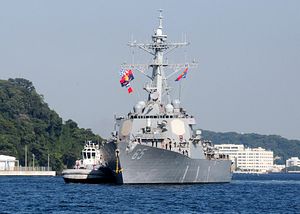In a speech at a naval shipyard this week, U.S. President Donald Trump’s national security advisor (NSA) announced that the U.S. Navy’s entire fleet of Arleigh Burke-class destroyers would eventually be armed with hypersonic weapons. However, the expense and effort required to modify those destroyers to accommodate the missiles leaves significant doubt that the entire class will be retrofitted.
NSA Robert O’Brien told audiences that the Navy’s Conventional Prompt Strike hypersonic weapon will be outfitted first on its Virginia-class attack submarines, then on the three advanced Zumwalt-class destroyers, and finally on all three variants of the Arleigh Burke-class destroyers.
The Navy’s hypersonic weapon is a boost-glide design. The warhead is first lifted to a high altitude by a rocket or missile; the weapon then detaches from the booster and glides unpowered at more than five times the speed of sound to its target.
The booster rocket that lofts the hypersonic vehicle to its operational altitude has a much wider diameter than most other Navy missiles. The newer Virginia-class attack submarines and Zumwalt destroyers are equipped with larger missile launchers that can accommodate the hypersonic weapon’s wide booster rocket.
The Arleigh Burke-class destroyers’ vertical missile launchers are too small to fit the weapon, however, and would need to be replaced with newer, larger launchers. With nearly 70 Arleigh Burke-class destroyers in service, retrofitting them all with new missile launchers would entail both extraordinary additional expense and tie up a huge swath of shipyard capacity.
The Navy still has maintenance backlogs and its aging ships are requiring progressively more maintenance to stay ready. Adding the additional burden of replacing that many launching systems might paralyze an already stressed maintenance and shipyard infrastructure.
Beyond the additional expense, many of the ships that would notionally receive the upgraded launchers and weapons have rapidly diminishing service life left, translating to an extremely low return on the Navy’s investment.
The Navy estimates that its hypersonic missile will be ready to deploy on the Virginia-class attack submarines by 2028 at the earliest. Since the decision was made not to extend the service lives of the older Burke destroyers earlier this year, the oldest of the class will likely begin to be retired in the mid-2020s, before the hypersonic missiles will even be ready for their deployment on submarines, let alone surface ships.
The added expense and shipyard strain that a class-wide launcher replacement would create during a decade where experts are already expecting flat or shrinking defense budgets suggests this plan is likely to be significantly scaled back, regardless of who wins the upcoming presidential election in the United States.
If the Arleigh Burkes do eventually receive a hypersonic weapon, it might instead be a smaller, scramjet cruise missile design that can fit in the existing launchers. The Russian Navy tested a surface-ship launched hypersonic cruise missile earlier this fall.
O’Brien emerged as a major champion of a 355-ship fleet within the Trump administration and appears to have influenced the defense secretary’s decision to scrap the Navy’s future fleet plan earlier this year and start developing a new plan out of his office. That plan, called Battle Force 2045, claims to establish a path to building a 355-ship fleet by 2035 and, through the addition of new generations of unmanned ships and submarines, a nearly 500-ship fleet by 2045. Experts and former senior Navy officials are deeply skeptical that the new plan is affordable.
It is unusual for a national security advisor to engage in the details of military procurement issues. At the start of the Trump administration, O’Brien was discussed as a possible candidate to be the Navy Secretary but was ultimately withdrawn from consideration for the post.

































